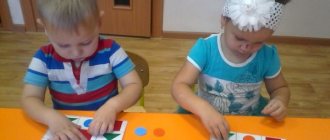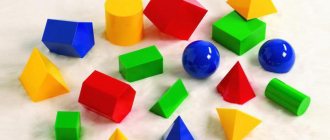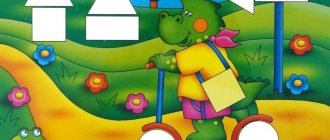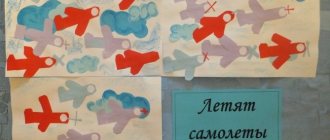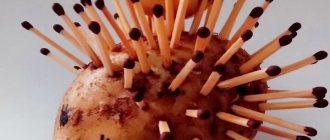Mathematics lesson in the younger group on the topic: Geometric shapes
Summary of a mathematics lesson at a preschool educational institution.
Second junior group Program content: - consolidate the concepts of wide - narrow, long - short, concepts of geometric shapes (circle, square, rectangle, triangle and oval);
- consolidate concepts about parts of the day, repeat ordinal and quantitative counting; — continue to develop the ability to work individually and in a team, develop thinking and logic; - Cultivate a respectful attitude towards each other. Progress of the lesson
Educator: Hello, guys! Do you want to get into a fairy tale? Children: Yes. Educator: Look, guys, there are paths in front of us. Are they the same or not? Children: No. Educator: How are they different? Children: Long. One is long and the other is short. Educator: Well done! And what else? Children: Width. One path is wide and the other is narrow. Educator: Good guys! This means they differ in length and width. What path do you think you should take to quickly get into a fairy tale? Children: We need to take the shortcut. Educator: That's right. Well, shall we hit the road? Boys should skip girls. Children walk one by one along a narrow path and find themselves in front of a tower. Educator: Here we are in a fairy tale. And it begins like this: “I was standing in a field ... (teremok). What is the name of this fairy tale? Children: "Teremok". Educator: We found ourselves in an unusual mathematical fairy tale. The heroes of this fairy tale can live in the little house if we complete their mathematical tasks. Let's get started. There was a tower in the field. A small mouse ran past. She decided to live in the mansion, but first we must complete her task. There are windows in the mansion. They are made in the form of geometric shapes. The mouse asks to name these figures. The teacher points to the figures, and the children name them. Children: Circle, square, triangle, rectangle, oval. Educator: Well done! We will put the mouse in a room with a window that has three corners and three sides. What figure are we talking about? Children: Triangle. The teacher attaches the mice. Educator: A frog frog jumped past. She also wants to live in the tower, but first she needs help. The frog's beads have scattered, you need to help collect them. Shall we try? The beads consist of geometric shapes. First there must be a figure that has 4 corners and 4 sides, all sides being equal. What figure is this? Children: Square. The teacher places a square on the board, the children work at the table with handouts. Educator: Next is a figure that has 3 corners and 3 sides. What is this figure? Children: Triangle. The teacher lays out the triangle on the board, and the children lay out their number cards. Educator: Then a figure that has no corners. What figure is this? Children: Circle and oval. Educator: There are two such figures. We are talking about a figure that looks like a wheel, it can be rolled. Children: It's a circle. The teacher lays out a circle, the children repeat. Educator: Now repeat this drawing further yourself. Children place shapes on number cards individually. The teacher checks. Educator: Did you all manage? We have collected beads for the frog and now we can place it in the little house. Attach a picture of a frog to a square window. A runaway bunny ran past. He brought us this task (takes out pictures with parts of the day). You need to arrange the pictures in the right order. The teacher shows pictures, the children explain their choice. Children answer and put pictures on the board. Educator: Well done! All these are parts of the day. Let's explain our choice. What do we do in the morning? Children: We do exercises, wash ourselves, have breakfast. Educator: What do we do during the day? Children: We walk, have lunch, sleep. Educator: What are we doing in the evening? Children: We play, have dinner, go home. Educator: What do we do at night? Children: At night we sleep. Educator: Good guys! You have completed the bunny's difficult task. Now he can live in the little house. Let's put him in a room with a rectangular window. Educator: A little fox-sister ran past. She brought a basket with fish and mushrooms in it. The fox asks us to count them. The teacher places fish on the board and the children count. (4 fish). The teacher lays out mushrooms, the children count (5 mushrooms). Educator: Tell me, are there the same number of mushrooms and fish? Children: No. Educator: What more? Less of what? Children's answers. How many more mushrooms are there than fish? (at 1). How can you make sure there are equal numbers of mushrooms and fish? Children: Add one fish or subtract one mushroom. Educator: We have completed the fox’s task, and now she can live in a little house in a room with an oval window. The children help find this room and place the little fox sister. Educator: A top ran past - a gray barrel. He also wants to live in the little house, but first you must complete his task on the pieces of paper. The teacher distributes the task, the children complete it individually. Did you all manage? Well done! Let's put the top in a room with a round window. Children attach a figurine of a top. Educator: And finally the bear came. Children, can we put the bear in the little house? Children: No. All rooms are occupied. Educator: We can build our own mansion for him. We have gymnastic sticks, let's use them to build a tower for the bear on the floor. Let's get started. The children build a little house and put a bear in it. Educator: The bear is very pleased and says thank you very much. What figures does our tower consist of? Children: From a triangle and a square. Educator: That's right. Let's count how many heroes there were in our fairy tale. (6). Who was the first? (Mouse). Who was third? (Bunny). Who's last? (Bear). Now let's count the animals backwards. Children count. Educator: Did you like our journey into a fairy tale? Children: Yes. Educator: Now it’s time to go back to kindergarten. Thank you. Well done! The children walk along the short path back.
We recommend watching:
Abstract of GCD for the formation of elementary mathematical concepts. Second junior group Notes of a lesson on FEMP in the first junior group of a preschool educational institution Notes of GCD in mathematics for the junior group of a kindergarten. Counting within 6 Summary of a lesson on mathematical development in the second junior group for gifted children
Similar articles:
Math lesson notes. Topic: "Circle". Second junior group
Scenario for mathematical entertainment in the younger group
Summary of a mathematical game in the second junior group
Summary of the game in mathematics in the 2nd junior group
Summary of a math lesson in the junior group “Ranking by height”
MAGAZINE Preschooler.RF
Summary of the mathematics lesson “Geometric figures” in the second junior group- Author: Abakumova Natalya Leonidovna
- Head: Nadezhda Vasilievna Mitrofanova
Program content: improve the ability to denote aggregates with the words one, many, none. Continue to learn to distinguish and name familiar geometric shapes: square, triangle. Practice classifying objects according to one characteristic.
Demo material:
Vegetable garden bed with vegetables, bucket, hare, geometric shapes (triangle, square).
Handout:
Geometric shapes (squares, triangles).
Progress of the lesson:
Organizing time:
- Hello guys!
- Guys, today a guest came to us from the forest. And try to guess who it is.
What kind of forest animal stands up like a post under a pine tree? Who stands among the grass with ears larger than his head?
(Hare)
— A hare came to us from the forest.
- Let's say hello to the hare (they say hello).
— Guys, our hare has a vegetable garden.
Main part:
Game situation “Harvesting vegetables .
There is an imitation of a vegetable garden on the board. The teacher invites the children to see what is growing in the garden. Children list vegetables (carrots, cucumbers, potatoes, etc.).
The teacher summarizes their answers: these are vegetables, then finds out:
— How many vegetables grew in the garden (a lot). Let's collect the vegetables in a bucket.
Children take one vegetable each, and the teacher clarifies:
- What vegetable did you take? How many vegetables did you take? Children take turns putting vegetables in the basket and comment: “I put one carrot (cucumber, carrots, potatoes, etc.) . The teacher accompanies the children’s actions with the words:
— There are more vegetables in the basket, and fewer in the garden. When the children fill the basket, the teacher finds out:
— How many vegetables are in the basket? (A lot) How many vegetables are left in the garden? (No one).
- Well done, you helped the hare harvest.
Guys, now look carefully at the board and tell me what geometric shapes you saw? (Square, triangle, circle).
- Right. Now tell our guest how these geometric shapes differ from each other.
(Children's answers).
- Okay, we completed the task.
Fizminutka:
The gray bunnies are sitting, (crouched down), their long ears stick out. (we show our ears with our hands) Here are our ears, Here are our ears;
Ears on top of head. Here is a little fox running, (running in place) Cunning little sister. Hide, hide, (crouched down.)
Jumping bunnies. Bunnies scattered across the forest clearing. (jumping in place) These are the bunnies,
Jumping bunnies.
- Guys, our guest is in trouble! His house is broken, can we help him build a new one? (Yes).
Game exercise “Let's build houses” .
The teacher distributes geometric shapes to the children. Then he gives tasks:
— What figures do you have on the table? Place the entire square in front of you. What pieces do you need to take to build a roof for a house? Place a triangle on a square - one triangle for each square. What did you get? (answers).
- Well done, you did the job well.
Final part:
- Guys, tell me, did you like helping the Hare today? (Yes).
Let's remember what we did today? (children's answers).
Well, now it’s time for us to say goodbye to our guest. He needs to return to the forest. Let's say goodbye to the hare.
- Goodbye!
- Well done boys. You did well today.
| Next > |
Program content: - consolidate the concepts of wide - narrow, long - short, concepts of geometric shapes (circle, square, rectangle, triangle and oval); - consolidate concepts about parts of the day, repeat ordinal and quantitative counting; — continue to develop the ability to work individually and in a team, develop thinking and logic; - Cultivate a respectful attitude towards each other.
Progress of the lesson
Educator: Hello, guys! Do you want to get into a fairy tale? Children: Yes. Educator: Look, guys, there are paths in front of us. Are they the same or not? Children: No. Educator: How are they different? Children: Long. One is long and the other is short. Educator: Well done! And what else? Children: Width. One path is wide and the other is narrow. Educator: Good guys! This means they differ in length and width. What path do you think you should take to quickly get into a fairy tale? Children: We need to take the shortcut. Educator: That's right. Well, shall we hit the road? Boys should skip girls. Children walk one by one along a narrow path and find themselves in front of a tower. Educator: Here we are in a fairy tale. And it begins like this: “I was standing in a field ... (teremok). What is the name of this fairy tale? Children: "Teremok". Educator: We found ourselves in an unusual mathematical fairy tale. The heroes of this fairy tale can live in the little house if we complete their mathematical tasks. Let's get started. There was a tower in the field. A small mouse ran past. She decided to live in the mansion, but first we must complete her task. There are windows in the mansion. They are made in the form of geometric shapes. The mouse asks to name these figures. The teacher points to the figures, and the children name them. Children: Circle, square, triangle, rectangle, oval. Educator: Well done! We will put the mouse in a room with a window that has three corners and three sides. What figure are we talking about? Children: Triangle. The teacher attaches the mice. Educator: A frog frog jumped past. She also wants to live in the tower, but first she needs help. The frog's beads have scattered, you need to help collect them. Shall we try? The beads consist of geometric shapes. First there must be a figure that has 4 corners and 4 sides, all sides being equal. What figure is this? Children: Square. The teacher places a square on the board, the children work at the table with handouts. Educator: Next is a figure that has 3 corners and 3 sides. What is this figure? Children: Triangle. The teacher lays out the triangle on the board, and the children lay out their number cards. Educator: Then a figure that has no corners. What figure is this? Children: Circle and oval. Educator: There are two such figures. We are talking about a figure that looks like a wheel, it can be rolled. Children: It's a circle. The teacher lays out a circle, the children repeat. Educator: Now repeat this drawing further yourself. Children place shapes on number cards individually. The teacher checks. Educator: Did you all manage? We have collected beads for the frog and now we can place it in the little house. Attach a picture of a frog to a square window. A runaway bunny ran past. He brought us this task (takes out pictures with parts of the day). You need to arrange the pictures in the right order. The teacher shows pictures, the children explain their choice. Children answer and put pictures on the board. Educator: Well done! All these are parts of the day. Let's explain our choice. What do we do in the morning? Children: We do exercises, wash ourselves, have breakfast. Educator: What do we do during the day? Children: We walk, have lunch, sleep. Educator: What are we doing in the evening? Children: We play, have dinner, go home. Educator: What do we do at night? Children: At night we sleep. Educator: Good guys! You have completed the bunny's difficult task. Now he can live in the little house. Let's put him in a room with a rectangular window. Educator: A little fox-sister ran past. She brought a basket with fish and mushrooms in it. The fox asks us to count them. The teacher places fish on the board and the children count. (4 fish). The teacher lays out mushrooms, the children count (5 mushrooms). Educator: Tell me, are there the same number of mushrooms and fish? Children: No. Educator: What more? Less of what? Children's answers. How many more mushrooms are there than fish? (at 1). How can you make sure there are equal numbers of mushrooms and fish? Children: Add one fish or subtract one mushroom. Educator: We have completed the fox’s task, and now she can live in a little house in a room with an oval window. The children help find this room and place the little fox sister. Educator: A top ran past - a gray barrel. He also wants to live in the little house, but first you must complete his task on the pieces of paper. The teacher distributes the task, the children complete it individually. Did you all manage? Well done! Let's put the top in a room with a round window. Children attach a figurine of a top. Educator: And finally the bear came. Children, can we put the bear in the little house? Children: No. All rooms are occupied. Educator: We can build our own mansion for him. We have gymnastic sticks, let's use them to build a tower for the bear on the floor. Let's get started. The children build a little house and put a bear in it. Educator: The bear is very pleased and says thank you very much. What figures does our tower consist of? Children: From a triangle and a square. Educator: That's right. Let's count how many heroes there were in our fairy tale. (6). Who was the first? (Mouse). Who was third? (Bunny). Who's last? (Bear). Now let's count the animals backwards. Children count. Educator: Did you like our journey into a fairy tale? Children: Yes. Educator: Now it’s time to go back to kindergarten. Thank you. Well done! The children walk along the short path back.
